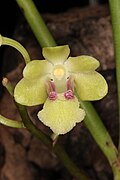| Image | Name | Distribution | Elevation (m) |
|---|
 | Holcoglossum amesianum (Rchb.f.) Christenson, 1987 | Yunnan, Assam, Myanmar, Vietnam, Thailand, Laos, Cambodia | 1,200–1,600 metres (3,900–5,200 ft) |
 | Holcoglossum auriculatum Z.J.Liu, S.C.Chen & X.H.Jin, 2005 | Yunnan, Myanmar, Vietnam, Thailand | |
 | Holcoglossum clausum K.P.Wojtas, C.Bandara & Kumar 2024 | Myanmar |
| Holcoglossum calcicola Schuit. & P.Bonnet, 2009 | Laos | |
 | Holcoglossum flavescens (Schltr.) Z.H.Tsi, 1982 | Fujian, Hubei, Sichuan, Yunnan | 1,200–2,000 metres (3,900–6,600 ft) |
 | Holcoglossum himalaicum (Deb, Sengupta & Malick) Aver. 1988 | Yunnan, Myanmar | 1,800–2,100 metres (5,900–6,900 ft) |
 | Holcoglossum kimballianum (Rchb.f.) Garay 1982 | Yunnan, Myanmar, Vietnam, Thailand, Laos | 1,200–1,800 metres (3,900–5,900 ft) |
| Holcoglossum × kunmingense D.K.Zhao, Ze Zhang & Rui B.Wang 2022 (H. flavescens × H. tsii) | Yunnan | |
 | Holcoglossum lingulatum (Aver.) Aver. 1990 | Guangxi, Yunnan, Vietnam | 1,000–1,300 metres (3,300–4,300 ft) |
 | Holcoglossum linearifolium Z.J.Liu, S.C.Chen & L.J.Chen 2011 | Yunnan | 1,500–2,000 metres (4,900–6,600 ft) |
| Holcoglossum nagalandense (Phukan & Odyuo) X.H.Jin 2012 | Assam (Nagaland) to China (W. Yunnan) and Vietnam | 1,600–2,000 metres (5,200–6,600 ft) |
 | Holcoglossum nujiangense X.H.Jin & S.C.Chen 2007 publ. 2008 | Yunnan | 2,500–3,000 metres (8,200–9,800 ft) |
| Holcoglossum omeiense X.H.Jin & S.C.Chen 2005 | Sichuan | 700–1,000 metres (2,300–3,300 ft) |
 | Holcoglossum phongii (Aver.) Aver. & O.Gruss 2016 | Vietnam | 50–150 metres (160–490 ft) |
 | Holcoglossum pumilum (Hayata) L.J.Chen, X.J.Xiao & G.Q.Zhang 2013 | Taiwan | 1,000–2,300 metres (3,300–7,500 ft) |
 | Holcoglossum quasipinifolium (Hayata) Schltr. 1919 | Taiwan | 1,800–2,800 metres (5,900–9,200 ft) |
 | Holcoglossum rupestre (Hand.-Mazz.) Garay 1972 | Yunnan | 2,000–2,400 metres (6,600–7,900 ft) |
| Holcoglossum semiteretifolium (Seidenf.) R.Rice 2018 | Arunachal Pradesh to N. Thailand | |
 | Holcoglossum singchianum G.Q.Zhang, L.J.Chen & Z.J.Liu 2013 | Yunnan | 1,300–1,500 metres (4,300–4,900 ft) |
 | Holcoglossum sinicum Christenson 1987 | Yunnan | 2,600–3,200 metres (8,500–10,500 ft) |
 | Holcoglossum subulifolium (Rchb.f.) Christenson 1987 | Hainan, Yunnan | 1,000–2,200 metres (3,300–7,200 ft) |
 | Holcoglossum tsii T.Yukawa 2000 | Sichuan, Yunnan | |
 | Holcoglossum wangii Christenson 1988 | Yunnan, Guangxi, Vietnam | 250–1,200 metres (820–3,940 ft) |
| Holcoglossum watsonii (Rolfe) J.M.H.Shaw 2021 | Vietnam | |
| Holcoglossum weixiense X.H.Jin & S.C.Chen 2003 | Yunnan | 2,500–3,000 metres (8,200–9,800 ft) |
|


















